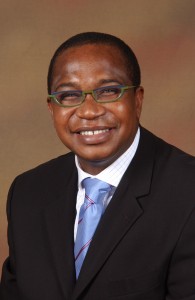

Follow us on:  
|


Policymakers need to focus on safeguarding stability and promoting prosperity in countries such as the DRC, Ncube says of new approaches to reduce poverty on the continent
African Development Bank Chief Economist and Vice-President Mthuli Ncube said that three large countries – Nigeria, Ethiopia, and the Democratic Republic of the Congo (DRC) – are key to poverty reduction in Sub-Saharan Africa.
His position is highlighted in Can dreams come true? Eliminating extreme poverty in Africa by 2030 – a new report he co-authored with advisor and research economist Zuzana Brixiova and Zorobabel Bicaba, consultant and PhD from the Paris School of Ecoomics.
Ncube said that their simulation forecasts found that under plausible assumptions on growth and redistribution, eliminating poverty by 2030 was out of the region’s reach.
However, a more realistic goal of reducing poverty by a range from half to two-thirds was achievable, he added.
“We found that even under our ‘best case’ scenario of accelerated consumption growth and income redistribution from the 10 per cent richest to the 40 per cent poorest segment of population, the 2030 poverty rate would be around 10 per cent instead of the target of three per cent,” Ncube said in an exclusive interview with The BRICS Post.
The report provided two policy implications.
The first was that any attempt to reduce poverty in Africa to very low levels needs to address poverty in large countries such as Nigeria.
The second implication was that since poverty in Africa will increasingly be concentrated in today’s fragile states (especially the DRC), policymakers need to focus on safeguarding stability and promoting prosperity in these countries.
“Our research, and those of others in places like Latin America, shows that income growth was the most important variable, so job creation needs to be the policy imperative. In that respect education is a key enabler, but without growth, government interventions in areas such as education, health and social protection are constrained,” Ncube said.
Growth needs to be inclusive
The report showed that the rapid growth that Africa as a continent exhibited since the early 2000s was a key factor behind its poverty reduction in the past decade.
In the future, the growth needs to be inclusive and generate decent jobs for large segments of the population – a conclusion reached in studying the experience from Latin American countries that were successful in poverty reduction.
Turning to the lessons that Africa could learn from the BRICS, Ncube said China showed that improving agricultural productivity was one of the ways of reducing poverty.
“African countries need to raise farming’s resilience to climate change impacts. Since Africa is not one country, it can raise its cohesion through integration to bridge inequities within and across societies,” he said.
In Brazil, the “Bolsa Familia” programme showed that governments could often play an important role in reducing poverty through well-designed redistributive programmes even in slower growing economies such as South Africa.
Meanwhile, India has shown that simple programmes such as Rwanda’s “one cow per family” could have a large impact on those in abject poverty. Russia provided an example of how natural resources could be used to alleviate poverty.
“Resource companies should have local procurement policies in place as even workers on offshore drill platforms need to have fresh fruit and vegetables and other consumables that can be manufactured locally,” Ncube added.
Turning to the International Monetary Fund and World Bank meetings taking place in Washington, Ncube said it appeared that global growth was improving.
“The green shoots have taken hold and are more vigorous. In countries like the United Kingdom and the United States growth has been faster than expected, which gives us hope that the global growth slowdown is over. The Ukraine crisis has emphasised the need to work together,” he concluded.
By Helmo Preuss in Pretoria, South Africa for The BRICS Post